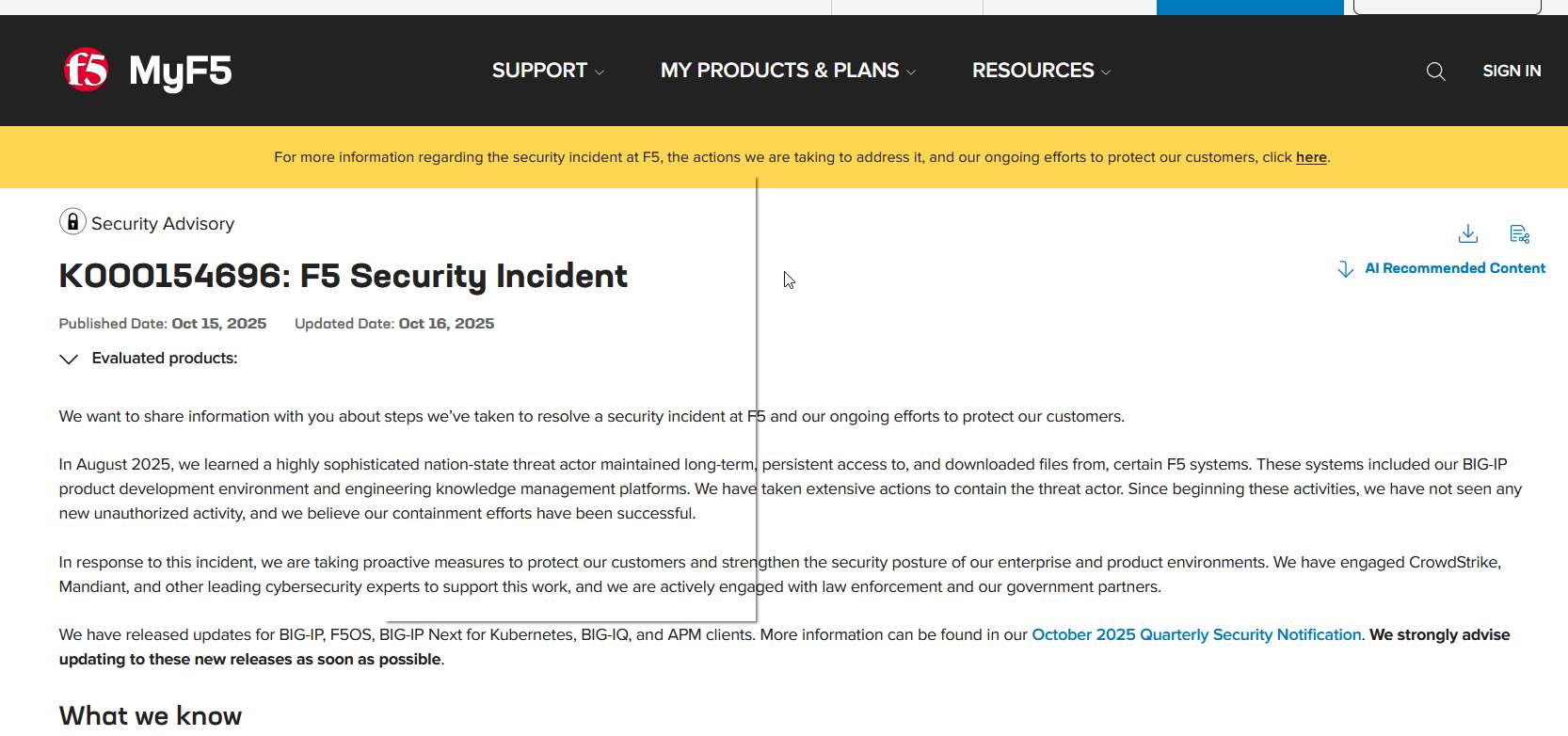In what is being described as one of the most consequential cyber-espionage operations of the year, US technology vendor F5 Networks has confirmed that nation-state threat actors successfully infiltrated its internal environment, stealing source code and vulnerability intelligence related to its flagship BIG-IP product line — a core networking and application delivery system used by governments, telecoms, and Fortune 500 companies worldwide.
Security officials fear that the stolen data could enable the attackers to weaponize undisclosed flaws in F5 devices, creating a new wave of zero-day exploits targeting critical infrastructure.

The Breach: A Year-Long Infiltration
F5 disclosed that it became aware of the incident in August 2025, when internal monitoring flagged suspicious activity in its product development and engineering knowledge management environments. Subsequent investigation revealed that a highly sophisticated nation-state group had maintained persistent, undetected access for at least 12 months.
The attackers exfiltrated:
- Source code for multiple BIG-IP modules (including TMOS and F5OS components).
- Internal documentation detailing unpatched or undisclosed vulnerabilities under active development.
- Limited configuration and implementation data for a small number of customers.
Although the company has not named the perpetrators, intelligence sources cited by Bloomberg have linked the breach to Chinese state-sponsored operators, echoing earlier campaigns targeting Cisco, VMware, and Fortinet.
Anatomy of the Attack
F5’s internal forensics, supported by CrowdStrike, Mandiant, and NCC Group, suggest a multi-stage intrusion resembling a hybrid of supply-chain and insider-infiltration tactics:
- Initial Access — Likely achieved via a compromised developer credential or third-party vendor account used to access F5’s build environment.
- Persistence and Lateral Movement — Attackers deployed stealthy implants, maintaining operational control over source repositories and knowledge systems for months.
- Exfiltration — Sensitive files were exfiltrated in small encrypted fragments to avoid detection by data loss prevention (DLP) systems.
- Cover-Up — The actors used time-based file manipulation and log tampering to mimic legitimate developer activity.
Sources close to the investigation said traces of a custom backdoor — codenamed “Brickstorm” — were found on several engineering servers. The backdoor reportedly established secure tunnels through legitimate development tools and was designed to remain dormant during business hours to evade behavioral analytics.

What Was — and Wasn’t — Compromised
F5 confirmed that the breach was isolated to BIG-IP and related development environments. There is no evidence that attackers accessed:
- F5’s CRM, finance, or customer support systems.
- NGINX (the enterprise reverse proxy and web server).
- Distributed Cloud Services or Silverline DDoS infrastructure.
Investigators found no tampering with production firmware or software update mechanisms — though experts caution that “absence of evidence is not evidence of absence.”
The F5 BIG-IP product line underpins critical operations in banks, data centers, military networks, ISPs, and government agencies. These systems handle SSL termination, load balancing, and access management — meaning any compromise could grant deep visibility into encrypted traffic.
Potential Threat Scenarios
- Zero-Day Exploit Development: Attackers could identify new vulnerabilities using stolen source code.
- Firmware Backdoor Implantation: Stolen build knowledge could enable weaponized updates.
- Targeted Espionage: Compromised BIG-IP instances could be used to monitor encrypted traffic or pivot into internal networks.
Security researchers warn that this breach may lead to a new class of “supply-chain espionage”, where adversaries weaponize vendor source code to attack the vendor’s customers months or even years later.
Containment and Response
After identifying the intrusion, F5 immediately engaged top cybersecurity firms:
- CrowdStrike deployed its Falcon EDR sensors across F5 infrastructure.
- Mandiant conducted forensics to map persistence mechanisms.
- NCC Group and IOActive performed integrity audits of BIG-IP’s build pipeline and codebase.
F5 says these reviews found no evidence of tampering or newly inserted malicious code.
To restore customer confidence, F5 also:
- Rotated all potentially compromised signing certificates and cryptographic keys.
- Redesigned network segmentation and access controls for its product development environments.
- Announced it will provide all supported BIG-IP customers with free access to CrowdStrike’s Falcon EDR for enhanced visibility.
Government Directives and Industry Reaction
CISA Emergency Order
The U.S. Cybersecurity and Infrastructure Security Agency (CISA) issued an emergency directive ordering all federal agencies to:
- Identify and inventory all F5 devices.
- Apply newly released F5 updates.
- Restrict external access to management interfaces.
- Decommission any end-of-life BIG-IP appliances.
Agencies must report compliance to CISA by December 3, 2025.
🇬🇧 UK NCSC Advisory
The UK’s National Cyber Security Centre (NCSC) confirmed that while there is no evidence of active exploitation, all customers should:
- Patch BIG-IP, BIG-IQ, BIG-IP Next, and F5OS systems.
- Review security hardening and monitoring configurations.
- Implement SIEM integration following F5’s threat-hunting guide.
Lessons for Enterprises
- Assume Vendor Compromise: Even trusted network security vendors can be breached.
- Zero Trust for Infrastructure Devices: BIG-IP and similar systems should never have unrestricted management interfaces exposed.
- Monitor for Brickstorm Indicators: F5’s internal threat-hunting guide includes patterns to detect the potential backdoor.
- Accelerate Patch Cycles: Organizations must apply F5’s latest updates immediately to close potential zero-days before they’re weaponized.
The F5 breach underscores a critical shift: attackers are targeting the builders, not just the users, of critical infrastructure.
By infiltrating product development environments, adversaries gain unprecedented power — the ability to insert vulnerabilities at the source or stockpile exploit intelligence to use at will.
In an interconnected world where devices like BIG-IP sit at the heart of traffic flows for global enterprises, this incident could redefine the urgency of secure software supply chains.
Key Takeaways
- F5’s BIG-IP source code and vulnerability research stolen by a nation-state actor (suspected Chinese APT).
- Intrusion lasted 12+ months before detection.
- Brickstorm backdoor discovered in the environment.
- No evidence of tampering in production firmware — but high future exploit risk.
- CISA and NCSC have issued urgent patching and mitigation directives.
The F5 BIG-IP breach is not just another corporate security lapse — it represents a strategic compromise of the global internet’s trust layer.
Attackers now possess insider-level knowledge of one of the world’s most widely deployed network security systems.
As enterprises rush to patch and monitor for hidden persistence, this event serves as a reminder: in 2025, the line between IT infrastructure and national security has effectively vanished.
Information security specialist, currently working as risk infrastructure specialist & investigator.
15 years of experience in risk and control process, security audit support, business continuity design and support, workgroup management and information security standards.
